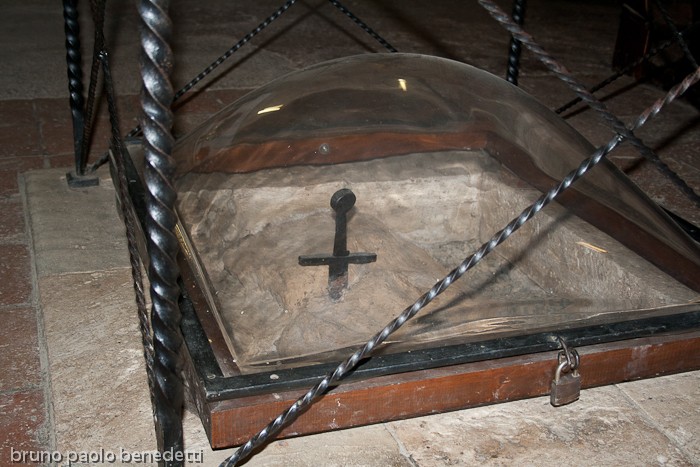Swords of renown are the seeds of legend. We’ve found swords that might in fact be legends brought to life; others have tales so bizarre we have to question their truth. There will never be another weapon that has left a greater impact on history as the sword––some more than others.
The Sword in The Stone

https://www.ancient-origins.net
While the Arthurian legend is mostly a product of folklore and myth, there is evidence that its sword in the stone tale might be very real. In a chapel in Monte Siepi, Italy lies an ancient sword embedded in stone. It’s believed that Saint Galgano was a 12th-century Tuscan knight whom Archangel Michael commanded to give up his sinful ways. Arguing that the task would be as difficult as cleaving stone, Galgano attempted to prove his point by breaking his sword on a nearby rock. Legend says his blade cut into the stone as if it were butter. The sword in the stone still rests where Galgano left it behind, along with his worldly ways.
The Kusanagi

According to legend, the “sword in the snake,” Kusanagi, was found in the body of an eight-headed serpent killed by the god of storms and seas. The Kusanagi is said to be housed in the Atsuta shrine in Nagano Prefecture, though it isn’t on public display and hasn’t been seen in centuries. The sword is occasionally brought out for imperial coronation ceremonies, but it’s always kept shrouded in wrappings. Official mention of the sword came after World War II—even though the late Emperor Hirohito disavowed any claim to his divinity, he was also recorded as having ordered the divine regalia’s keepers to “defend them at all costs.”
Durandal

For hundreds of years, a mysterious sword had been embedded in the cliffs above the Notre Dame chapel in Rocamadour, France. The monks say it is Durandal, sword of the paladin Roland. Since the 12th century, the chapel has been a destination for sacred pilgrimages. In 2011, the sword was removed by the local municipality and given to the Cluny Museum in Paris for an exhibit.
The Cursed Muramasas

https://www.ancient-origins.net
Muramasa was an ancient Japanese swordsmith who, according to legend, prayed that his swords would be “great destroyers.” There are countless stories of the Muramasas’ wielders going mad or being murdered. The swords were believed to be cursed, and were banned by imperial edict. The edict was made by Shogun Tokugawa Ieyasu, who condemned the swords after they killed nearly all of his family. Muramasa was not the name of one man, but the entire school of swordsmiths he founded. Quality Muramasa blades had been produced for close to a century and Japan’s warrior class used them often.
The Honjo Masamune

http://goldstuff.blogspot.com/
In contrast to Muramasa’s cursed swords are the blades of legendary priest and swordsmith Masamune. While Masamune’s works are valued as Japanese national treasures, one of the swords has never been found. Following Japan’s surrender in WWII, the “Honjo Masamune” was given to an American soldier, Sgt. Coldy Bimore, who most likely took it home with him as a war souvenir. As the mysterious G.I. has never been found, the sword’s whereabouts have likewise been lost. Despite the sword’s doubtless worth (it is potentially worth millions), sword collectors are no closer to finding the legendary lost Masamune than they were the day it disappeared.
Joyeuse

Joyeuse, King Charlemagne’s legendary sword, was said to change colors 30 times every day, and was so bright it outshone the sun. Since as early as 1271, two swords called Joyeuse have been part of French coronation ceremonies. But since both swords can’t be the famed Joyeuse, the mystery of which one is the true sword of the Holy Roman Emperor has lingered for centuries. The other contender is the “saber of Charlemagne” housed in the Imperial Treasury in Vienna. It is unknown how the sword became part of the French Imperial Regalia, but the saber is dated to the early 10th century—closer than the Joyeuse sword.
St. Peter’s Sword

There are several legends about the sword used by Saint Peter when he cut off the ear of the servant to the high priest in the garden of Gethsemane. English lore has it brought to England by Joseph of Arimathea along with the Holy Grail. In 968, however, a sword was brought to Poland by Bishop Jordan—a sword which he claimed was the actual sword of St. Peter. The Bishop’s sword, considered the true relic, remained in Poland and was eventually moved to the Archdiocese Museum in Poznan.
The sword in Poland is a falchion—a type of sword likely not in use during Saint Peter’s time. Metallurgy tests have also dated it to long after the saint’s death.
The Wallace Sword

Legend has it that William Wallace––the titular character of Mel Gibson’s Braveheart––used human skin for his sword’s scabbard, hilt, and belt. The flesh’s donor was said to have been Hugh de Cressingham, treasurer of Scotland, whom Wallace had flayed after defeating him in the battle of Stirling Bridge. The sword as it is now, in the National Wallace Monument, bears the replacement parts.
The Sword Of Goujian

In 1965, a remarkable sword was found in a damp tomb in China—despite being over 2,000 years old, there wasn’t a spot of rust on it. The blade was so untouched by time it even drew blood when one archeologist tested its edge on his finger. Study of the etchings concluded that it was a sword belonging to the Yue king, Goujian, and is believed to be the legendary blade mentioned in The Lost History of Yue. Tests show the swordsmiths of Yue had reached such a high level of metallurgy they were able to incorporate rust-proof alloys into their blades. Their swords were also treated with rust-resistant chemicals, helping them survive the ages relatively unblemished.
The Seven-Branched Sword

https://michael-chen-mg2n.squarespace.com
In 1945, a mysterious sword was found in Japan’s Isonokami shrine. The sword was of exceedingly unusual make, with six protrusions branching out from its sides (the tip is considered its seventh). The sword was in poor condition, but a faded inscription could be made out along the blade. The exact translation has been questioned numerous times, but what is clear is that the sword was a gift from a Korean king to a Japanese monarch. The dating on the blade matched reliable sources in China, Korea, and Japan.
Related Content
Awesome Facts about South KoreaOccasions in history when things were NSFWRidiculous Murder Defenses That Actually Worked
This post was created with our nice and easy submission form. Create your post!






Comments
Loading…